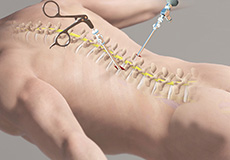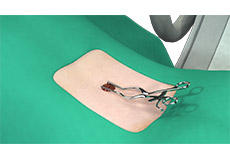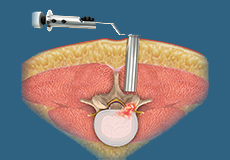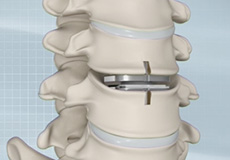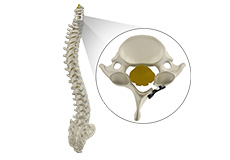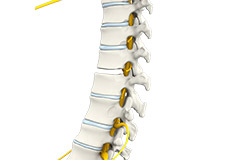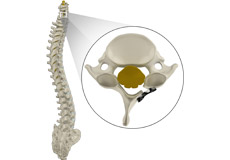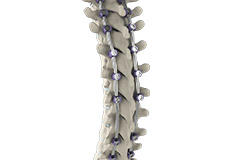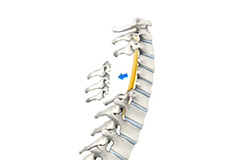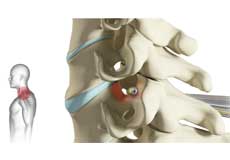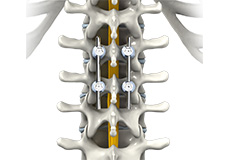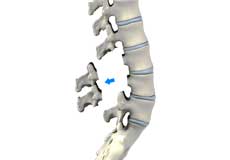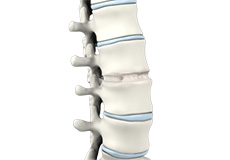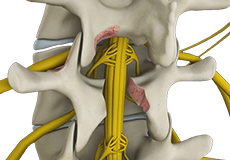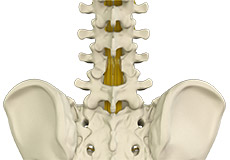- Anatomy
- Conditions
- Procedures
General
Minimally Invasive Spine Surgery
Minimally invasive spine surgery (MISS) is the latest technology available to perform spinal surgeries through small, less than one-inch-long incisions.
Complex Spine Surgery
Complex spine surgery is a procedure that involves six or more vertebrae of the spinal column, requiring six or more hours of surgery to correct a spinal deformity.
Outpatient Spine Surgery
Outpatient spine surgery is an operative procedure that does not require an overnight stay at the hospital. It is also called ambulatory or same-day surgery.
Motion-Sparing Surgery
Motion preservation surgery or Motion Preservation Spine Surgery (MPSS) is a relatively new surgical method employed as an alternative to standard spinal surgeries,
Microscopic Spine Surgery
Microdiscectomy is a surgical procedure employed to relieve the pressure over the spinal cord and/or nerve roots, caused by a ruptured (herniated) intervertebral disc.
Cervical Disc Replacement
The cervical spine is located in the neck region and consists of seven bones arranged one on top of the other. Cushioning tissue called vertebral discs located between the vertebrae act as shock absorbers, allowing easy movement of the neck.
Cervical Laminoplasty
Degeneration of the facet joints and intervertebral discs that connect vertebrae to one another results in narrowing of the spinal canal, known as spinal stenosis.
Computer Navigation Surgery/Image-Guided Spine Surgery
The spine is a complex 3- dimensional structure that is interspersed with a complex lattice of delicate blood vessels and nerves. Trauma to these structures during surgery is a big concern in spinal surgery.
Minimally Invasive Scoliosis Surgery
The goal of scoliosis surgery is to both reduce the abnormal curve in the spine and to prevent it from progressing further and getting worse.
Spinal Fusion
Spinal fusion is the surgical technique of combining two or more vertebrae. A fusion of the vertebrae involves the insertion of secondary bone tissue obtained either from an autograft (tissues from your own body) or allograft (tissues from another person) to enhance the bone healing process.
Spinal Decompression
Spinal decompression is a treatment to relieve pressure on one or many “pinched nerves” in the spinal column. It can be achieved either surgically or by non-surgical methods.
Spine Deformity Surgery
The spine or backbone provides stability to the upper part of the body. It helps to hold your body upright. It consists of several irregularly-shaped bones called vertebrae appearing in a straight line.
Disc Decompression
Acute or chronic injury can cause a spinal disc to herniate or rupture. The damaged disc may compress against the spinal cord or the nerves that branch out through the vertebral bones, leading to pain, loss of sensation and/or motor function in the part of the body supplied by the nerve.
Spine Rehabilitation
Dysfunction of the spine can be severely debilitating to one’s ability to perform activities at both home and work. Pain in the lumbar spine (lower back) is the number one reason for missed days of work, followed by the pain of the cervical spine (neck).
Physical Therapy for the Spine
Physical therapy is one of the foremost necessary treatment modes of recovery for back pain. A referral to physiotherapy sometimes is created by your spine surgeon.
Complications of Spinal Surgery
The most serious complication of a herniated disc that may occur before surgery is the development of the cauda equine syndrome. It occurs when a large particle of disc material ruptures in the spinal canal.
Post-op Rehabilitation
Rehabilitation is a treatment method designed to facilitate recovery after a serious injury, illness, or surgery. It is aimed at restoring the physical, sensory, intellectual, psychological, and social functions of the patient.
Pre-Surgical Rehabilitation
Pre-surgical rehabilitation or “prehab” is a preparative exercise program prior to surgery that helps improve overall surgical outcomes.
Degenerative Spine Surgery
Degenerative spine surgery includes surgical procedures to treat degenerative spine conditions such as disc disease and spinal stenosis that can result in the gradual deterioration of the spine with pain and loss of function.
Cervical
Neck Surgery
Neck surgery is a surgical procedure employed for the treatment of neck pain when conservative measures such as physical rehabilitation, medications, and rest have failed to provide any relief to your neck pain.
Cervical Laminectomy
Degeneration of the facet joints and intervertebral discs results in narrowing of the spinal canal known as spinal stenosis. In addition, the arthritic facet joints become bulkier and consume the space available for the nerve roots.
Cervical Foraminotomy
Cervical foraminotomy is a surgical procedure performed to relieve the symptoms of a pinched or compressed spinal nerve by enlarging the neural foramen, an opening for the nerve roots to exit the spine and travel through the body.
Cervical Spine Fusion
Your spine consists of a spinal cord supported by a series of interlocking bones called vertebrae. The cervical spine is the upper part of the spine situated in the neck region.
Artificial Cervical Disc Replacement
Disc degeneration reduces the height of the disc and may cause a Herniated disc. The vertebrae of the backbone are cushioned by intervertebral discs that act as shock-absorbers and allow frictionless movement of your back.
Cervical Microdiscectomy
Your spine consists of 24 bones called vertebrae that are arranged one above the other and separated by intervertebral discs which act as shock absorbers during activity.
Cervical Laminectomy and Fusion
Cervical laminectomy is a surgical procedure in which the spinal canal is made larger by removing the spinous process and the lamina in the cervical region of the spine.
Lumbar
Lumbar Laminectomy
Lumbar laminectomy is a spinal surgery to relieve excess pressure on the spinal cord or nerves within the spinal canal in the lumbar or lower back region.
Lumbar Fusion
Spinal fusion, also called arthrodesis, is a surgical technique used to join two or more vertebrae (bones) within the spine. Lumbar fusion is the procedure of fusing the vertebrae in the lumbar portion of the spine (lower back).
Lumbar Decompression
Lumbar decompression is a surgical procedure performed to relieve pressure over the compressed nerves in the lower spine (lumbar region).
Laminectomy
Laminectomy refers to the removal or cutting of the lamina (roof) of the vertebral bones to provide space for the nerves to exit from the spine.
Treatment Options for Back and Neck Pain
Back and neck pain is common symptoms of injury, damage, deformity, or unhealthy spinal conditions. Pain may range from a mild ache to a sharp shooting pain that can spread down your arms and legs.



